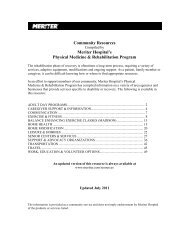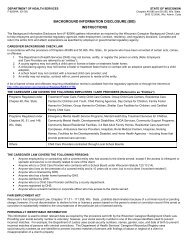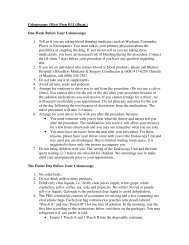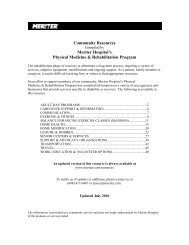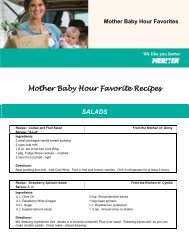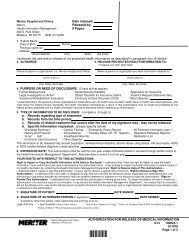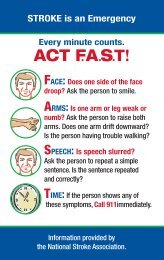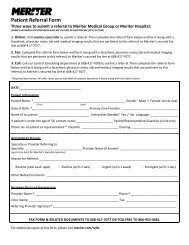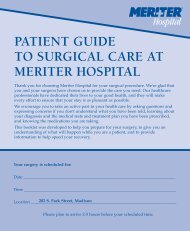A Guide To Your New Family's First Weeks - Meriter Health Services
A Guide To Your New Family's First Weeks - Meriter Health Services
A Guide To Your New Family's First Weeks - Meriter Health Services
Create successful ePaper yourself
Turn your PDF publications into a flip-book with our unique Google optimized e-Paper software.
Expressing and Storing Breast Milk<br />
Having stored breast milk available is convenient<br />
for occasions when you are separate from your baby<br />
or when you return to work. (Please note: These<br />
guidelines for milk expression and storage are for<br />
healthy full-term babies.)<br />
• Press your thumb and fingers straight into the<br />
chest wall and then move them together in a<br />
pressure-release rhythm. You may need to do this<br />
a few times to get the milk to flow.<br />
Ways to Express <strong>Your</strong> Milk<br />
You may choose to hand express your milk or use a<br />
breast pump:<br />
• If you do not anticipate being separated from your<br />
baby very often, hand expressing or using a hand<br />
pump works well.<br />
• If you plan to return to work or be away from<br />
your baby for a period, using an electric breast<br />
pump is a good idea. A single<br />
pump is meant for occasional<br />
use, and pumps one breast at a<br />
time. Double pumps (pumping<br />
both breasts at one time) are more<br />
efficient, and are often the most<br />
effective way to pump and increase<br />
your milk production.<br />
You may purchase or rent a breast pump. Since there<br />
are many varieties of pumps available, it may be a<br />
good idea to discuss your options with a health care<br />
provider.<br />
Helping <strong>Your</strong> Milk “Let Down”<br />
Having your baby at the breast helps trigger the<br />
hormones that allows your milk to “let down” or<br />
flow. Such natural cues are missing when you express<br />
your milk, so you need to create other cues that<br />
signal your body to let the milk down. The following<br />
suggestions should help.<br />
• Get into a comfortable position.<br />
• Minimize distractions.<br />
• Warmth is relaxing. Apply heat to your breast, or<br />
put a sweater or blanket around your shoulders.<br />
• Stimulate your nipples by gently rubbing or rolling<br />
them.<br />
• Relax. Think about nursing your baby. Look at<br />
your baby’s picture. Listen to something relaxing.<br />
Hand Expression<br />
• Wash your hands before expressing milk.<br />
• Place your thumb and first two fingers on either<br />
side of the nipple, approximately<br />
1- 1 ⁄2 inches behind the nipple.<br />
Please note these guidelines<br />
for milk expression<br />
and storage are for<br />
healthy full-term babies.<br />
29<br />
Push Roll Finish Roll<br />
• Continue to do this until the flow of milk slows<br />
down, usually 3-5 minutes.<br />
• Switch to the other breast and repeat.<br />
• Go back to the first breast and rotate your hand so<br />
you are expressing milk from other parts of your<br />
breast.<br />
• Repeat again, switching between<br />
breasts as the milk flow slows.<br />
• Hand expression usually takes 20-30<br />
minutes. <strong>Your</strong> breasts should be<br />
softer. With practice and patience, it<br />
gets easier to do and the amount you<br />
are able to express will increase.<br />
Pumping<br />
Read the pump instructions carefully before use.<br />
The first time you use the pump, adjust the suction<br />
regulator to minimum. You may increase the suction<br />
as you become comfortable using the pump, but it<br />
should not cause nipple soreness. Center the shield<br />
over the nipple so it draws the nipple in and out<br />
without rubbing against the sides. When you start the<br />
pump, you should feel a tugging similar to how your<br />
baby nurses. You should not be uncomfortable when<br />
you pump. If pumping is causing discomfort, a larger<br />
breast shield may help.<br />
If you are using an electric pump, keep it at breast level<br />
to reduce the possibility of milk moving back into the<br />
pump. If you are pumping instead of nursing, double<br />
pump for 15 minutes.<br />
If you are using a single pump, pump for a total of<br />
30 minutes and switch breasts when the milk flow<br />
decreases, or about every 5 minutes.




